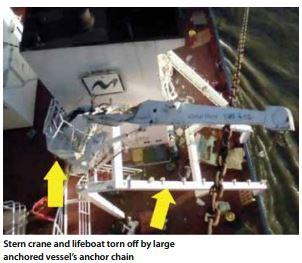202204 Anchorage disaster movie
As edited from NTSB (USA) report DCA16FM018
A small general cargo vessel was due to travel downriver. While still on the berth, the pilot determined that he would not be able to reach the end of the daylight-only restriction zone before darkness fell. He discussed a plan with the Master to begin the transit, but go to an intermediate anchorage for the night. The only available anchorage was an area approximately 1.1 miles in length and 100 metres wide. That area already had three vessels at anchorage and river currents were running strong due to high water conditions.
The transit downriver was without incident. With the assistance of two tugboats, the vessel was anchored at 16:00 using both anchors, placed at the ten and two o’clock positions respectively. By about 16:17 the anchor chains had become taut and the stern of the vessel was about 152 metres from the bow of a much larger general cargo vessel anchored astern. At about 16:26, as the pilot boat approached to disembark the pilot, the vessel’s bow swung quickly into the river current. By the time the pilot regained the bridge the ship was almost perpendicular to the river. The pilot requested ‘half ahead and starboard’ but the engines were not able to overcome the force of the river current, and the anchors dragged. A few seconds later the pilot informed the Master that they were going to collide with the bulk carrier anchored astern. The pilot radioed the two tugboats that had been assisting during the anchoring, requesting that they return as quickly as possible. The ship’s whistle was used to sound the danger signal and warn of the impending collision.
About 15 minutes after being ‘safely’ anchored, the vessel was being carried by the current at a speed of 5.5 knots. The vessel drifted until its propeller caught the starboard anchor chain of the larger vessel anchored astern. The entanglement pulled the drifting vessel’s propeller shaft outward damaging reduction gears and cracking the gear box.

Subsequently, the small cargo vessel drifted toward the port anchor chain and bow of the larger anchored vessel. The anchored vessel’s port anchor chain caught and then wrapped around the drifting vessel’s stern crane, holding the vessel in place as the current pivoted it around the bow of the bulk carrier. The crane and the stern mounted lifeboat of the drifting vessel were destroyed. The highest point on the drifting vessel’s aft deckhouse was well below the main deck of the larger anchored vessel, and the bridge wing of the drifting vessel was torn off.
The larger anchored vessel began to manoeuvre under power as the bridge team tried to mitigate the consequences of the collision. Their initial manoeuvre of coming ahead caused the drifting vessel to list. With no propulsion, the bridge wing torn off, the ship listing, and the anchor chain of the large vessel still wrapped around the stern, the drifting vessel’s crew mustered on their vessel’s main deck near the cargo hatch covers. The list became so great that it was decided to abandon ship, and the crew transferred onto one of the tugboats that had returned to the scene.
A few minutes later, the anchor chain of the larger vessel broke, freeing the drifting vessel. Once released from the chain, the vessel floated free, and the crew returned to their ship as it drifted down the port side of the larger vessel. The vessel was subsequently corralled by five tug boats and the situation stabilised. Damages to the drifting vessel were confirmed at over two million USD.
The official investigation found, among other things, that the anchorage used was originally designed for three vessels, and was normally occupied by only two. At the time of the accident, there were four vessels anchored there. After the accident, local authorities reassessed the risks of the anchorage for high-water periods and decided to limit occupancy to one vessel.
Lessons learned
- While hindsight is said to be 20:20, we can still learn from this accident that even competent local authorities can underestimate risks in a waterway system. The reassessment of risks subsequent to the accident demonstrates that indeed, lessons were learned.
- In tight anchorages and strong currents, main engines should always be on standby and the vessel’s position checked as if the vessel is underway. In this case the vessel went from being anchored to a disaster movie within 15 minutes. Thankfully, no injuries to crew were incurred.
